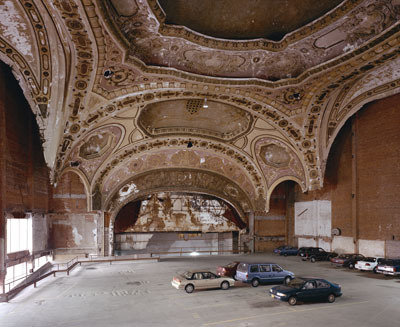Stan Douglas
dal 25/9/2013 al 16/1/2014
Segnalato da
25/9/2013
Stan Douglas
Canadian Cultural Centre, Paris
A retrospective look at the photographic work he produced in the last decade of the 20th century, "Abandonment and Splendour" explores the ruins of certain great Western utopias in their paradoxical beauty. The exhibition focused on four series.

Curator Catherine Bédard
A retrospective look at the photographic work produced
by Stan Douglas in the last decade of the twentieth century,
Abandonment and Splendour explores the ruins of certain
great Western utopias in their paradoxical beauty.
The exhibition focused on four series haunted by a history
between light and shadow that the image does not explain
but evokes with the poetic suspense that is the artist’s hallmark.
The presence of colonial empires in indigenous territories in the
very west of Canada, the application of reforming community
models and their transformation (a Ruskinian colony that had
given its name to an industrial region of British Columbia; the
allotments, or “Schrebergärten”, of Potsdam), the idea of progress
and the modernist ideal are some of the issues that appear in
these projects which Stan Douglas reframes historically and
subjectively. The artist takes an interest in disused, deserted,
forgotten places that bear inside them the memory of history
and the profound marks that it left on the local history of
disappeared communities.
While the photographs of Ruskin Photos, Potsdamer Schrebergärten,
Nootka Sound and Detroit Photos are intimately tied to film and
video installations based on these places, they also collectively
comprise a mysterious and unsettling representation of the
power and opacity of the image. Abandonment and Splendour
brings together thirty-six works produced in the 1990s. It chooses
to confront the viewer with the most silent part of an oeuvre
that deploys itself elsewhere in the moving image and sound.
Separated from the installations that they often accompany,
Stan Douglas’ photographs here display their own density, at a
remove from the narrative of the installation. From this ensemble
emerges a disturbing splendour fictitiously devoid of any
presence other than that of the artist.
Stan Douglas lives is Vancouver. A major figure in contemporary
art, he produces films, photographs and installations in which
past and present are condensed in complex systems that borrow
as much from Hollywood and television, as they do from literature,
music and philosophy. His works have been presented as part
of many group exhibitions including Documenta IX, X and XI in
Kassel (1992, 1997, 2002) and three Venice Biennales (1990, 2001,
2005). His most recent exhibitions have been held at the ZKM/
Museum für Neue Kunst, Karlsruhe (Fast Forward 2: The Power
of Motion, 2010), Solomon R. Guggenheim Museum, New York
(Haunted: Contemporary Photography/Video/Performance, 2010),
International Center of Photography, New York (3rd ICP Triennial
of Photography and Video: Dress Codes, 2009 and Archive Fever:
Uses of the Document in Contemporary Art, 2008), and Hirshhorn
Museum and Sculpture Garden, Washington, D.C. (The Cinema
Effect: Illusion).
Le Carré d’Art – Musée d’Art Contemporain de Nimes presents
the exhibition Stan Douglas from October 12, 2013 to January 26,
2014, in partnership with the Canadian Cultural Centre.
Image: Michigan Theater, from "Detroit Photos" series, 1999. Photograph. Courtesy of the artist and David Zwirner Gallery NYC, London.
Press Contact:
Jean Baptiste Le Bescam +33 (0)1 44432148 jean-baptiste.lebescam@international.gc.ca
Vernissage, Wednesday, September 25, 2013, 6 p.m. (last admission: 8:30 p.m.)
Visit the exhibition in the artist’s presence at 5 p.m. (reservations required: 01 44 43 21 48)
Canadian Cultural Centre
5 rue de constantine, Paris 7ème
Hours: Monday–Friday 10am–6pm
Free admission



